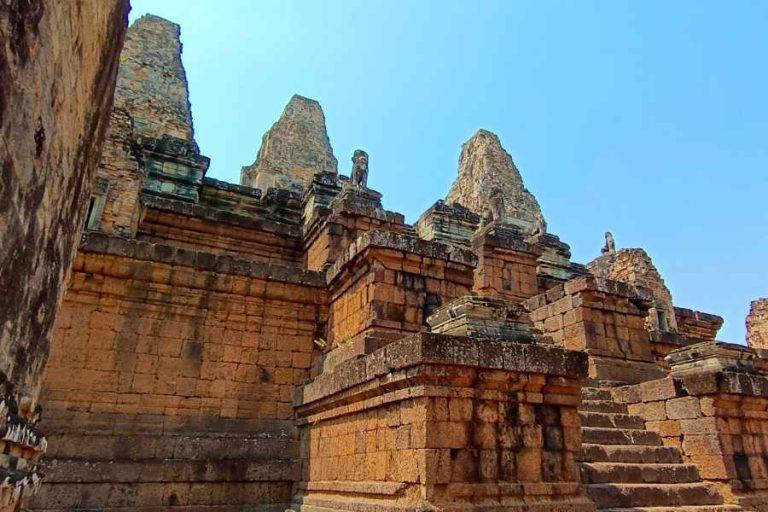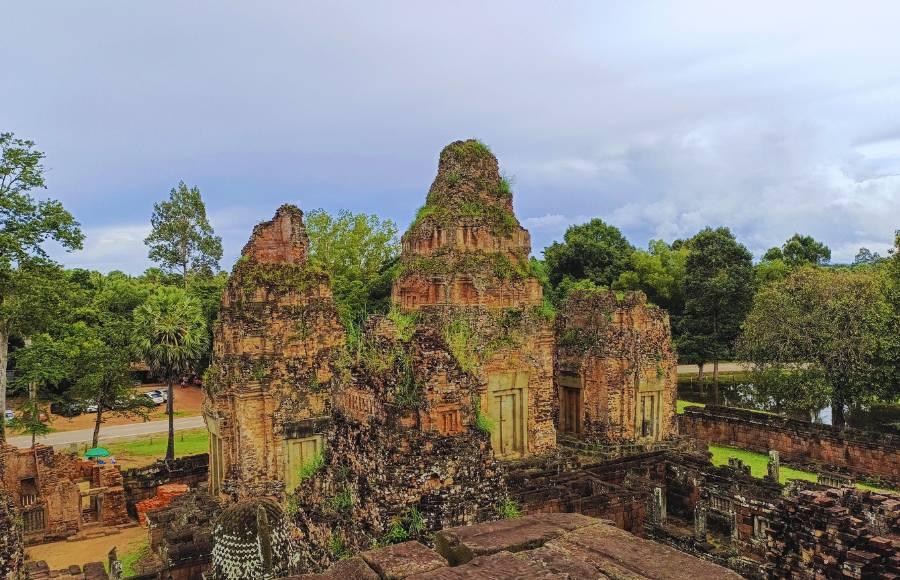A Window into Angkor’s Storied Khmer Past
Nestled deep within the ancient temple city of Angkor lies an enigmatic structure that has mesmerized visitors for centuries. Pre-Rup Temple, constructed in the 10th century during the reign of King Rajendravarman, stands as a testament to the rich history and artistic brilliance of the mighty Khmer empire. This ancient Hindu temple, dedicated to the god Shiva, provides an alluring glimpse into rituals and culture long forgotten.
For history aficionados, architecture enthusiasts, or anyone fascinated by the glories of Southeast Asia’s past, a visit to mysterious Pre Rup offers an unparalleled opportunity to immerse oneself in Angkor’s mystical Khmer heritage. Join us as we explore the legends, symbolism, and architectural mastery of this beguiling temple, and unravel the secrets of the ancient temple city’s most enchanting sanctum.
The Khmer Empire’s Rise and Fall Sets the Stage for Pre-Rup Temple
To fully appreciate [Pre Rup’s] grandeur, we must first understand the backdrop against which this temple emerged. Starting in the 9th century, the Khmer Empire grew to become one of the dominant powers in Southeast Asia, controlling the region politically and influencing culture.
The Khmer kings competed to construct ever more elaborate temples honoring Hindu deities, especially Shiva. Fueled by wealth from trade and agriculture, the empire reached its peak under Suryavarman II in the 12th century when the iconic Angkor Wat was built.
However, by the 14th century, the empire declined amidst infighting and external threats. Pre-Rup Temple was constructed during the final prosperous years before Angkor’s fall, serving as a monument to this culminating epoch.
Pre Rup Temple – An Architectural Masterpiece Honoring Shiva
Built completely from durable laterite and brick, [Pre Rup] exemplifies the Khmer Empire’s architectural brilliance. Constructed in 961 AD under King Rajendravarman II’s rule, the temple follows a traditional quincunx pattern with long corridors on four sides leading up to the central tower.
The external walls showcase exquisite bas-reliefs depicting scenes from Hindu mythology. Shiva, the Hindu god of destruction and regeneration, features prominently in these ornate carvings.
Intricate images of mythical Nāga serpents protected by seven-headed cobras adorn the gates, signaling the temple’s purpose – honoring Shiva. One can almost hear the chanting of Vedic hymns praising Shiva at this ancient sanctuary.
Five lotus-shaped towers rise above the sprawling temple complex, representing the five peaks of Mount Meru, the mythical abode of the gods per Hindu cosmology. The central tower denotes Shiva’s hallowed mountain domain.
The Central Towers and Their Symbolism
The five central towers are the heart of [Pre Rup Temple]. The tallest central tower housed the main shrine to Shiva. The four shorter corner towers were dedicated to other deities – Vishnu, Shiva’s consort Parvati, and Vishnu’s consort Lakshmi.
Curiously, each tower stands slightly off-center on the upper platform, possibly aligning with constellations holding ritual significance. Only the central-eastern door provided temple access; the other doors are beautifully carved false doors. Gods like Indra and Vishnu stand guard next to the functional eastern entrance.
The Intricate Bas Reliefs and Carvings
The basreliefs decorating Pre Rup offer intricate glimpses into Hindu mythology. Many depict stories of Shiva from the sacred texts, showing him dancing, meditating, and destroying demons. Other carvings showcase Vishnu, Brahma, Krishna, Rama, and other gods.
Seven-headed serpents called Nagas represent protection and fertility. Carvings of the elephant god Ganesha, monkeys, lions, and other sacred animals abound in the gallery narrating tales now shrouded in mystery.
The Libraries and Inner Sanctuaries
Two libraries flank the eastern entrance, likely filled with Hindu iconography and manuscripts. Inside, 12 smaller sanctuaries encircle the tiered pyramid, each containing statues honoring Shiva. Ceremonial halls connect the outer and inner galleries where rituals occur.
At the pyramid’s base sits a 3-meter platform thought to hold a statue of Nandi, Shiva’s bull mount. This entire layout reflects Hindu cosmology and ritual.

Decoding the Mysteries and Symbolism of Pre-Rup Temple
Beyond its architectural brilliance, the temple contains many puzzles awaiting decoding.
The name Pre Rup translates to “turning the body” in Khmer, likely referring to Hindu funeral rites, suggesting the temple hosted royal cremations. Each tower’s off-center alignment may have astronomical significance. The durable construction hints at anticipating instability. Later modifications like the five peaks reflect Buddhist iconography.
Previous Theories on Purpose and Meaning
Many aspects of the rup spark debate. Historians question whether it hosted cremations or solely served religious ceremonies. The namesake could also reference funeral rites or the Hindu god Vishvarupa. The isolated location may indicate a former capital city as theorized by Philippe Stern.
While its original purpose remains ambiguous, the temple clearly demonstrates the Khmer Empire’s cultural and architectural excellence through its elaborate artistry and Hindu-Buddhist syncretism.
Daily Life and Rituals at Pre-Rup Temple During the Khmer Empire
Though the details are hazy, we can envision the activities within [Pre Rup] centuries ago. Hindu rites and rituals would have been conducted daily, locals would gather to socialize and pray, and special ceremonies would mark events like funerals.
Religious Ceremonies and Worship
As a temple devoted to Shiva, Pre Rup would have reverberated with the chanting of Vedic hymns, drumming, and music praising the god. Worshippers blessed statues, made offerings, and meditated. Large crowds likely gathered for annual festivals.
Royal Funerals and Cremations
If used for royal funerals, Pre Rup provided elaborate cremation ceremonies for the Khmer aristocracy. Bodies were placed on the central platform, as the funeral progressed through various ritual stages aligning with the temple layout before cremation.
Hub of Activity for Angkor Residents
Beyond ceremonies, Pre Rup bustled with locals gathering to pray, chat, and keep up with the news. For Angkor citizens, the temple stood at the heart of social and religious life.
Rediscovering Pre-Rup Temple in Modern Times
After being abandoned and reclaimed by the jungle in the 16th century, [Pre Rup] was eventually rediscovered centuries later by French explorers.
Lost to the Jungle and Rediscovered
With the fall of Angkor, [Pre Rup] was slowly consumed by jungle overgrowth. Hidden beneath vines and roots, it remained mostly unknown for hundreds of years until French archaeologists began excavations in the late 19th century.
Restoration Efforts and Current Condition
Major restoration occurred in the 1930s, clearing vegetation and reconstructing crumbling sections. Today Pre Rup is a protected World Heritage Site, drawing visitors to appreciate its preserved carvings and towering temples. Though damaged by time, its splendor endures.
Visiting Pre Rup Temple: Tips for Your Trip
An adventure discovering Pre Rup’s history and architecture is unforgettable. Here are tips to plan your visit:
- Visit in the early morning or late afternoon for optimal lighting.
- Dress appropriately by covering your legs and shoulders.
- Hire a knowledgeable local guide to explain symbols and myths. Our Banteay Srei Backcountry Tour provides an expert.
- Enter via the east gate and explore the outer areas first.
- Walk barefoot inside temple compounds.
- Bring water, wear sunscreen and a hat.
Let the grandeur and mysteries of Pre Rup Temple leave you in awe. Use these tips to uncover its storied past on an unforgettable Cambodian temple adventure!
The Enduring Allure of the Magnificent Pre-Rup Temple
The enigmatic Pre-Rup Temple has captivated visitors for a millennium through its striking architecture and mysterious aura. As one of Angkor’s last great monuments, it exemplifies the Khmer Empire’s cultural brilliance through its ornate artistry and Hindu-Buddhist syncretism.
Though many details are lost to time, its towering towers and exquisite carvings give us a glimpse into a civilization at its peak. For those drawn to Angkor’s magic, a journey to discover Pre Rup’s secrets promises adventure, insight into Cambodia’s glories, and inspiring encounters with its storied past.
Frequently Asked Questions About the Magnificent Pre-Rup Temple
Where is Pre Rup Temple located?
[Pre Rup Temple] is located within the ancient temple complex of Angkor, Cambodia. It sits just south of the East Baray reservoir and is aligned along a north-south axis with the East Mebon temple, which is on an island in the middle of the baray.
Pre Rup is situated about 6 kilometers east of Angkor Thom and 14 kilometers northeast of Siem Reap. Its convenient location makes it easy to access as part of a tour of the main Angkor temples. Visitors typically enter from the east, where there’s parking space for vehicles.
 +855 12 200 073
+855 12 200 073
 siemreapsharedtour@gmail.com
siemreapsharedtour@gmail.com





